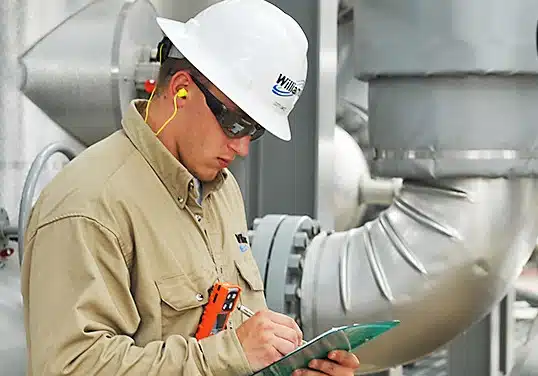Liquid Penetrant Testing (PT), also known as Dye Penetrant Inspection (DPI) or Fluorescent Penetrant Inspection (FPI), is a widely used nondestructive testing (NDT) method. It is used to detect surface-breaking defects in non-porous materials, such as metals, plastics, or ceramics. This method is straightforward, cost-effective, and can be used on large areas and complex shapes.
Following is a Step-by-step process of how Liquid Penetrant Testing is conducted:
1. Surface Preparation:
• Clean the Surface: The test surface must be clean and free of any contaminants like oil, grease, dust, or paint. Contaminants can prevent the penetrant from entering defects.
• Dry the Surface: Ensure the surface is dry before applying the penetrant.
2. Application of Penetrant:
• Apply the Penetrant: A liquid penetrant is applied to the surface of the test material. This penetrant is usually a bright color (visible dye) or fluorescent (under UV light).
• Dwell Time: Allow the penetrant to soak into any surface-breaking defects. The dwell time depends on the material and defect size, typically ranging from a few minutes to half an hour.
3. Excess Penetrant Removal:
• Remove Excess Penetrant: After the dwell time, the excess penetrant on the surface is removed carefully. For visible dye penetrants, this is often done with a clean, lint-free cloth and a solvent. For fluorescent penetrants, water or an emulsifier might be used.
• Ensure Clean Surface: Ensure that the surface is clean and only the penetrant in the defects remains.
4. Application of Developer:
• Apply Developer: A developer is applied to draw the penetrant out of the defects and onto the surface, creating a visible indication. Developers come in various forms: dry powder, wet aqueous, or non-aqueous (solvent-based).
• Development Time: Allow the developer to dry and give time for the penetrant to bleed out from defects, making them visible.
5. Inspection:
• Inspect the Surface: Examine the surface under appropriate lighting. For visible dye penetrants, this is normal light. For fluorescent penetrants, UV light is used.
• Identify Defects: Look for indications of defects. They will appear as bright lines or spots where the penetrant has been drawn out by the developer.
6. Post-Cleaning:
• Clean the Surface: After inspection, clean the part to remove all residues of penetrant and developer, especially if the part will be put into service.
Advantages of Liquid Penetrant Testing:
• Versatility: Can be used on a wide variety of non-porous materials.
• Sensitivity: Effective in detecting small surface-breaking defects.
• Simplicity: The method is straightforward and doesn’t require complex equipment.
• Cost-Effective: Relatively low cost compared to other NDT methods.
Limitations:
• Surface Breaking Only: Can only detect defects open to the surface.
• Surface Preparation Required: The surface must be thoroughly cleaned, which can be time-consuming.
• Material Limitations: Not suitable for porous materials, as the penetrant would seep into the material itself.
• Environmental Concerns: Some penetrants and developers might be hazardous or require special disposal methods.


